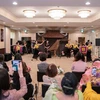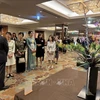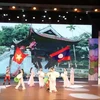Preserving unique architectural features and authentic traditional customs of ethnic minority groups is an effective and necessary move for conserving and promoting Vietnamese cultural identities.
This view was shared by cultural researchers and managers at a seminar in Hanoi on Nov. 24, reviewing the implementation of the national target programme on preserving traditional villages of ethnic minority groups over the past ten years.
The programme has been carried out in 20 villages of the ethnic minority groups of S’Tieng, Cham, Bana, K’Ho, M’nong, Ede, Van Kieu, Kho Mu, Muong, Thai, H’Mong, Lo Lo, Tay, Dzao, and Khmer, in 20 provinces nationwide.
It has assisted ethnic minority people in the target localities to protect traditional architectural features of their communal meeting halls and their homes, as well as preserving intangible cultural values, including their own festivals, folk songs and dances, traditional costumes and handicrafts.
Authentic customs and practices the target ethnic minority groups have tried to preserve have been collected, performed and introduced to the public through cultural exchange activities held in the framework of the programme.
In addition, the programme has facilitated the effective implementation of the Party and State’s ethnic policies, especially policies pertaining to poverty reduction, education, healthcare, family planning and childcare.
Economically, the ethnic minority beneficiaries have learnt to make profits from their own cultural and tourism products, farm produce and traditional handicraft items, to further improve their material life.
The seminar participants agreed that the preservation of ethnic minority villages has greatly contributed to raising the awareness of branches, sectors and even ethnic people on the position and significance of conserving and promoting the unique values of ethnic cultures.
The work has also helped create new cultural values, with culture becoming a spiritual goal and a driving force of ethnic minority people in the course of boosting their social development.
The preservation of ethnic minority villages has provided a new model, along with experiences for the State management agencies to better their organisation of preservation and promotion of traditional cultures at the grassroots level to help ethnic minority-inhabited areas develop in a sustainable manner, seminar participants agreed./.
This view was shared by cultural researchers and managers at a seminar in Hanoi on Nov. 24, reviewing the implementation of the national target programme on preserving traditional villages of ethnic minority groups over the past ten years.
The programme has been carried out in 20 villages of the ethnic minority groups of S’Tieng, Cham, Bana, K’Ho, M’nong, Ede, Van Kieu, Kho Mu, Muong, Thai, H’Mong, Lo Lo, Tay, Dzao, and Khmer, in 20 provinces nationwide.
It has assisted ethnic minority people in the target localities to protect traditional architectural features of their communal meeting halls and their homes, as well as preserving intangible cultural values, including their own festivals, folk songs and dances, traditional costumes and handicrafts.
Authentic customs and practices the target ethnic minority groups have tried to preserve have been collected, performed and introduced to the public through cultural exchange activities held in the framework of the programme.
In addition, the programme has facilitated the effective implementation of the Party and State’s ethnic policies, especially policies pertaining to poverty reduction, education, healthcare, family planning and childcare.
Economically, the ethnic minority beneficiaries have learnt to make profits from their own cultural and tourism products, farm produce and traditional handicraft items, to further improve their material life.
The seminar participants agreed that the preservation of ethnic minority villages has greatly contributed to raising the awareness of branches, sectors and even ethnic people on the position and significance of conserving and promoting the unique values of ethnic cultures.
The work has also helped create new cultural values, with culture becoming a spiritual goal and a driving force of ethnic minority people in the course of boosting their social development.
The preservation of ethnic minority villages has provided a new model, along with experiences for the State management agencies to better their organisation of preservation and promotion of traditional cultures at the grassroots level to help ethnic minority-inhabited areas develop in a sustainable manner, seminar participants agreed./.



















